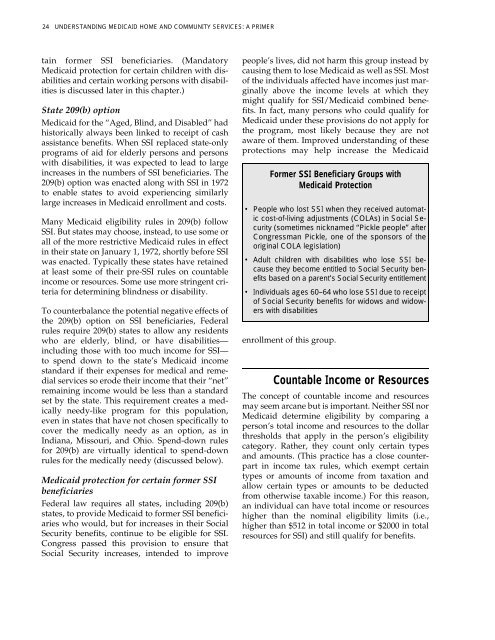Full PDF Version - ASPE - U.S. Department of Health and Human ...
Full PDF Version - ASPE - U.S. Department of Health and Human ...
Full PDF Version - ASPE - U.S. Department of Health and Human ...
- No tags were found...
Create successful ePaper yourself
Turn your PDF publications into a flip-book with our unique Google optimized e-Paper software.
24 UNDERSTANDING MEDICAID HOME AND COMMUNITY SERVICES: A PRIMERtain former SSI beneficiaries. (M<strong>and</strong>atoryMedicaid protection for certain children with disabilities<strong>and</strong> certain working persons with disabilitiesis discussed later in this chapter.)State 209(b) optionMedicaid for the “Aged, Blind, <strong>and</strong> Disabled” hadhistorically always been linked to receipt <strong>of</strong> cashassistance benefits. When SSI replaced state-onlyprograms <strong>of</strong> aid for elderly persons <strong>and</strong> personswith disabilities, it was expected to lead to largeincreases in the numbers <strong>of</strong> SSI beneficiaries. The209(b) option was enacted along with SSI in 1972to enable states to avoid experiencing similarlylarge increases in Medicaid enrollment <strong>and</strong> costs.Many Medicaid eligibility rules in 209(b) followSSI. But states may choose, instead, to use some orall <strong>of</strong> the more restrictive Medicaid rules in effectin their state on January 1, 1972, shortly before SSIwas enacted. Typically these states have retainedat least some <strong>of</strong> their pre-SSI rules on countableincome or resources. Some use more stringent criteriafor determining blindness or disability.To counterbalance the potential negative effects <strong>of</strong>the 209(b) option on SSI beneficiaries, Federalrules require 209(b) states to allow any residentswho are elderly, blind, or have disabilities—including those with too much income for SSI—to spend down to the state’s Medicaid incomest<strong>and</strong>ard if their expenses for medical <strong>and</strong> remedialservices so erode their income that their “net”remaining income would be less than a st<strong>and</strong>ardset by the state. This requirement creates a medicallyneedy-like program for this population,even in states that have not chosen specifically tocover the medically needy as an option, as inIndiana, Missouri, <strong>and</strong> Ohio. Spend-down rulesfor 209(b) are virtually identical to spend-downrules for the medically needy (discussed below).Medicaid protection for certain former SSIbeneficiariesFederal law requires all states, including 209(b)states, to provide Medicaid to former SSI beneficiarieswho would, but for increases in their SocialSecurity benefits, continue to be eligible for SSI.Congress passed this provision to ensure thatSocial Security increases, intended to improvepeople’s lives, did not harm this group instead bycausing them to lose Medicaid as well as SSI. Most<strong>of</strong> the individuals affected have incomes just marginallyabove the income levels at which theymight qualify for SSI/Medicaid combined benefits.In fact, many persons who could qualify forMedicaid under these provisions do not apply forthe program, most likely because they are notaware <strong>of</strong> them. Improved underst<strong>and</strong>ing <strong>of</strong> theseprotections may help increase the MedicaidFormer SSI Beneficiary Groups withMedicaid Protection• People who lost SSI when they received automaticcost-<strong>of</strong>-living adjustments (COLAs) in Social Security(sometimes nicknamed “Pickle people” afterCongressman Pickle, one <strong>of</strong> the sponsors <strong>of</strong> theoriginal COLA legislation)• Adult children with disabilities who lose SSI becausethey become entitled to Social Security benefitsbased on a parent’s Social Security entitlement• Individuals ages 60–64 who lose SSI due to receipt<strong>of</strong> Social Security benefits for widows <strong>and</strong> widowerswith disabilitiesenrollment <strong>of</strong> this group.Countable Income or ResourcesThe concept <strong>of</strong> countable income <strong>and</strong> resourcesmay seem arcane but is important. Neither SSI norMedicaid determine eligibility by comparing aperson’s total income <strong>and</strong> resources to the dollarthresholds that apply in the person’s eligibilitycategory. Rather, they count only certain types<strong>and</strong> amounts. (This practice has a close counterpartin income tax rules, which exempt certaintypes or amounts <strong>of</strong> income from taxation <strong>and</strong>allow certain types or amounts to be deductedfrom otherwise taxable income.) For this reason,an individual can have total income or resourceshigher than the nominal eligibility limits (i.e.,higher than $512 in total income or $2000 in totalresources for SSI) <strong>and</strong> still qualify for benefits.
















